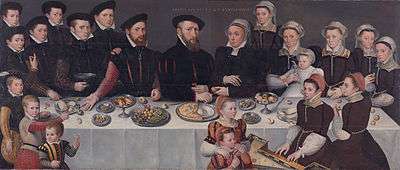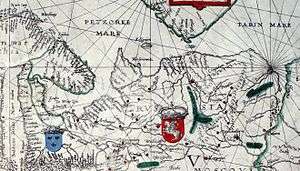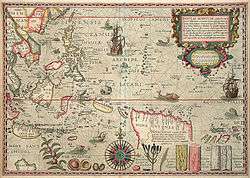Balthazar de Moucheron

Balthazar de Moucheron (Antwerp,1552 - France, ± 1630) was a Dutch trader and ship owner and was one of the founders of the Dutch East India Company. Although he is known for his early trading with India (and Indonesia), Balthazar de Moucheron was active in a much wider geographic area, like the Mediterranean Sea, America,[1] the west coast of Africa, the Baltic Sea and the White Sea.
Early life
His father Pierre de Moucheron (1508-1565) was from the (at that time) French province le Perche (parish Boissy-le-Sec in the south of Verneuil-sur-Avre) and was a descendant of the impoverished House of Bouley Moucheron. He moved to Middelburg in 1530, and found a job with the trader Antoine de Gerbier and married his daughter Isabeau in 1533. Balthazar de Moucheron's father became a wealthy merchant, he was in business with the Netherlands, France, Spain and England. In 1545 he moved his handelshuis (trade house) to Antwerp, at that time the trading centre of the region.[2]
Background
Alexander Farnese was sent to subdue the revolt in the southern Netherlands, in 1584 the Spanish controlled most of the area, only a handful of great cities were out of their control. In the besieged city of Antwerp, a Night Watch was assembled, of which Balthasar de Moucheron was one of the colonels. After a failed attempt by Holland and Zeeland to free the city, Antwerp surrendered. Balthasar was one of the leaders that negotiated its capitulation, the terms of surrender stated that all protestant citizens had 4 years time to leave the city and settle elsewhere. In 1585, after the Fall of Antwerp, Balthazar moved his business to Middelburg. In 1597 he acquired a house in Veere. Although he is known for his early trading with India (Indonesia), Balthazar de Moucheron was active in a much wider geographic area, like the Mediterranean Sea, America,[3] the west coast of Africa, the Baltic Sea and the White Sea. Balthazar de Moucheron sent his brother Melchior as a trading agent to the mouth of the Dwina at the Baltic Sea.
Northern passage

Balthazar de Moucheron played an important role in the search for a northern passage to the Indies.[4] He was most likely inspired by his connection with Olivier Brunel. He sent a first request to prince Willem van Oranje in 1584 that remained unanswered, because of the turbulent times for the Dutch state. For that reason Balthazar de Moucheron and Brunel initiated the discovery on their own account, with limited success. A new request in 1594 was accepted by the prince, but it was deamed of too high of an importance for the state for two traders to conduct it for their own account, the Staten Generaal (precursor of the parliament) took over control at this point. In 1594 Zeeland and Amsterdam equipped four ships for the expedition. Willem Barentsz sailed out for account of the city of Amsterdam and Cornelis Nay for Zeeland. Moucheron accepted reluctantly, but was not very happy that he was only appointed as an advisor for this expedition. The fleet sailed on 5 June 1594. They were hampered by large plains of ice, but on 11 August they found open waters on the Kara Sea, and assumed this was the long hoped passage to China. The fleet returned to the Netherlands and reported back on these findings.
Trade routes through Kaap de Goede Hoop
In 1597 Cornelis de Houtman succeeded in the so-called Eerste Schipvaart (first expedition) to sail to Indonesia via Cape of Good Hope. From this moment on, Moucheron focussed on that trade route. Moucheron founded the Veerse Compagnie and became a main shareholder. In 1598 the Veerse Compagnie sent two ships, De Leeuw (the lion) and the Leeuwin (the lioness), under the supervision of Cornelis and Frederik de Houtman to East-India. The fleet returned in 1600 without the two brothers. Cornelis was killed and Frederik was captured on Atjeh. Initially the expedition was not a financial success.[5]
In 1598 Moucheron sent five more ships, with a crew of 100 sailors and 150 soldiers, on a mission to capture Príncipe on the West-African shore, with the goal of erecting a supply point for further explorations.[6] The expedition managed to conquer the island on the Portuguese by list and intrigue, but before reinforcements arrived, the island was re-captured.
Expedition to Indonesia

Joris van Spilbergen sailed in May 1600 commissioned by Moucheron with four ships to India, the expedition didn't reach its destination, but returned home after they managed to conquer a Spanish ship on the way.
Through a merger of the Veerse compagnie and the Middelburgsche Compagnie (Compagnie van Tenhaeff) in November 1600 the Verenigde Zeeuwse Compagnie (United company of Zeeland) was founded, but Moucheron left the company at that point. Only Pieter van Hecke en Pierre le Moyne remained loyal to de Moucheron, they formed the Compagnie van De Moucheron in 1601. Moucheron's company did eventually help with the founding of the Dutch East India Company, but demanded a payment delay, protection from his creditors and free passage on the east coast of Africa.
In 1601 he sent Joris van Spilbergen with three ships, Ram, Schaap, and Lam, on a successful expedition to establish trade relations with the Kingdom of Kandy, and they eventually were to reach Atjeh.[7][8] Van Spilbergen met the king of Kandy (Sri Lanka) Vimala Dharma Suriya in 1602, and discussed the possibility of trade in cinnamon. When van Spilbergen returned to Zeeland in 1604, carrying on board a treasure of rubies, sapphires, topazes and a variety of other gemstones, which he received as a gift from the maharajah of Kandy, the independent companies of Holland and Zeeland had already merged to form the Dutch East India Company.
One year before the expedition returned from their great travels, Balthazar de Moucheron had declared bankruptcy and had fled to France.[9]
Personal life and death
Balthazar de Moucheron was married twice. His first wife was Jacqueline de la Croix. In 1591 he remarried in Delft with Elysabeth Berwoudts Van Crompvliet.[10] Balthazar de Moucheron died in poverty in France.
Citations
References
- ↑ Uit het Registre van de Besoignee van de gemeyne saecken der cooplieden tracerende op Spaengien ende andere plaetsen Westwaerts tsindts den jare 1581, fol. 15 en A.A.B. Deel 32, blz. 22. in the city archives of Antwerp it stated that he was one of the advocates of founding a trading company for the trade in what is now America in 1583, which didn't happen at that time
- ↑ Henry C. Murphy (2010). Henry Hudson in Holland. New York: Cosimo Classics. p.6.
- ↑ Uit het Registre van de Besoignee van de gemeyne saecken der cooplieden tracerende op Spaengien ende andere plaetsen Westwaerts tsindts den jare 1581, fol. 15 en A.A.B. Deel 32, blz. 22. in the city archives of Antwerp it stated that he was one of the advocates of founding a trading company for the trade in what is now America in 1583, which didn't happen at that time
- ↑ Henry C. Murphy (2010). Henry Hudson in Holland. New York: Cosimo Classics. p.12.
- ↑ Henry C. Murphy (2010). Henry Hudson in Holland. New York: Cosimo Classics. p.6.
- ↑ The Dutch Cape Colony was only to be founded in 1652 by Jan van Riebeeck .
- ↑ Vimala Dharma Suriya I of Kandy LankaLibrary.com retrieved 22 August 2009
- ↑ Anthonisz, Richard Gerald. The Dutch in Ceylon, Asian Educational Services, Colombo, 1929
- ↑ Donald F. Lach, Edwin J. Van Kley (1993). Asia in the Making of Europe, vol.III. p. 373.
- ↑ Doop- Trouw- en Begraafboeken - Gemeentearchief Delft
Sources:
- Unger, W.S. (1948) De oudste reizen van de Zeeuwen naar Oost-Indië. De Linschoten-Vereeniging LI. Den Haag: Martinus Nijhoff.
- Jonge, Jhr. Mr. J.K.J. de (1862) De opkomst van het Nederlandsch gezag in Oost-Indië, (1595-1610) Eerste deel Den Haag: Martinus Nijhoff
- ’’De familie de Moucheron’’. Rijksmuseum. URL bezocht op 12 april 2008.
- Wijnroks, E.H. (2003) Handel tussen Rusland en de Nederlanden, 1560-1640 Hilversum